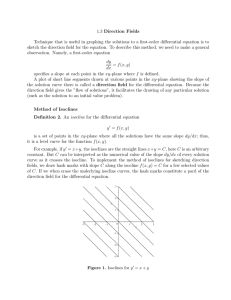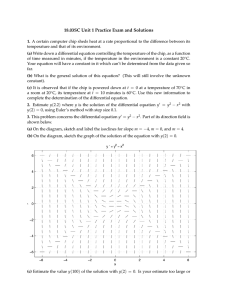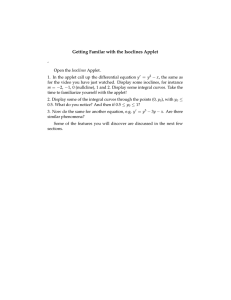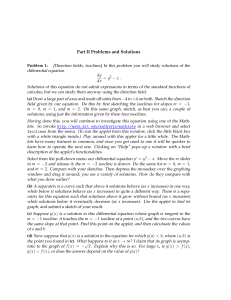18.03SC Differential Equations, Fall 2011 Direction Fields Transcript –
advertisement
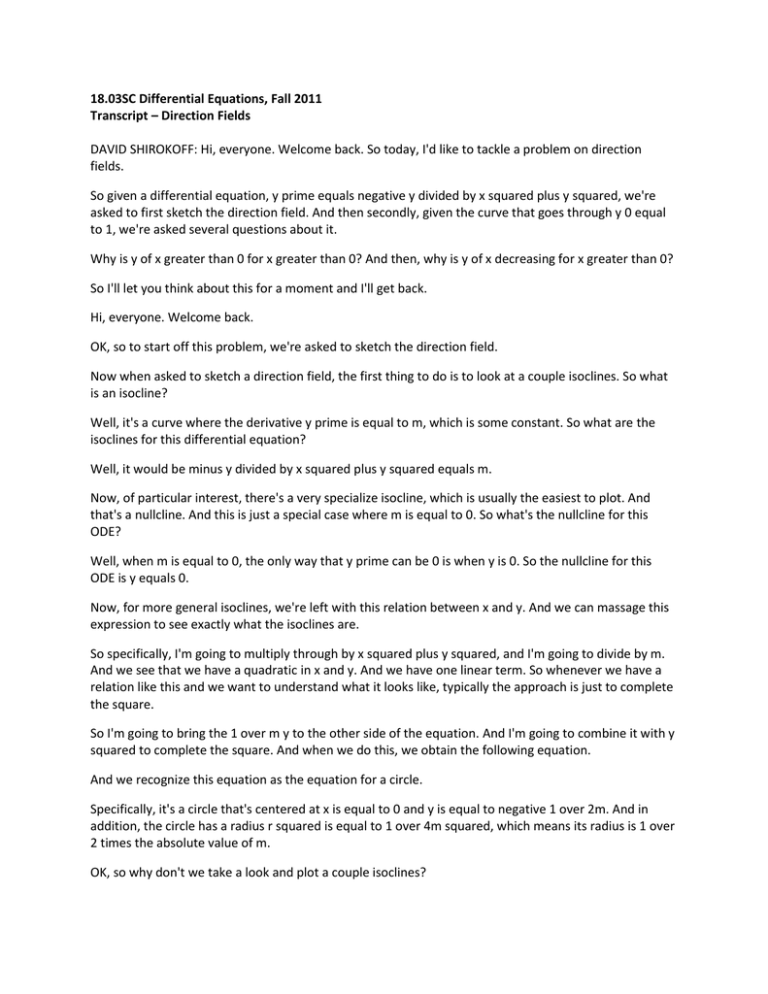
18.03SC Differential Equations, Fall 2011 Transcript – Direction Fields DAVID SHIROKOFF: Hi, everyone. Welcome back. So today, I'd like to tackle a problem on direction fields. So given a differential equation, y prime equals negative y divided by x squared plus y squared, we're asked to first sketch the direction field. And then secondly, given the curve that goes through y 0 equal to 1, we're asked several questions about it. Why is y of x greater than 0 for x greater than 0? And then, why is y of x decreasing for x greater than 0? So I'll let you think about this for a moment and I'll get back. Hi, everyone. Welcome back. OK, so to start off this problem, we're asked to sketch the direction field. Now when asked to sketch a direction field, the first thing to do is to look at a couple isoclines. So what is an isocline? Well, it's a curve where the derivative y prime is equal to m, which is some constant. So what are the isoclines for this differential equation? Well, it would be minus y divided by x squared plus y squared equals m. Now, of particular interest, there's a very specialize isocline, which is usually the easiest to plot. And that's a nullcline. And this is just a special case where m is equal to 0. So what's the nullcline for this ODE? Well, when m is equal to 0, the only way that y prime can be 0 is when y is 0. So the nullcline for this ODE is y equals 0. Now, for more general isoclines, we're left with this relation between x and y. And we can massage this expression to see exactly what the isoclines are. So specifically, I'm going to multiply through by x squared plus y squared, and I'm going to divide by m. And we see that we have a quadratic in x and y. And we have one linear term. So whenever we have a relation like this and we want to understand what it looks like, typically the approach is just to complete the square. So I'm going to bring the 1 over m y to the other side of the equation. And I'm going to combine it with y squared to complete the square. And when we do this, we obtain the following equation. And we recognize this equation as the equation for a circle. Specifically, it's a circle that's centered at x is equal to 0 and y is equal to negative 1 over 2m. And in addition, the circle has a radius r squared is equal to 1 over 4m squared, which means its radius is 1 over 2 times the absolute value of m. OK, so why don't we take a look and plot a couple isoclines? So as I mentioned before, typically the first isocline that we should plot is the nullcline, which is m is equal to 0. And we know that this is y is equal to 0. So all along the line y is equal to 0, I'm just going to dry dashes that correspond to a slope of y is equal to 0. From the other isoclines, we just have to pick some values of m and start plotting. So I'll take the value m is equal to negative 1. And when m is equal to negative 1, we have a circle which is centered at 0 and 1/2 with radius 1/2. So here's 1/2. Here's 1. And at every point along the circle, we just draw a little slope of negative 1. So at every point along this curve, the solution has slope negative 1. Now, in addition, we can also get another circle, which is centered at negative 1/2. And this corresponds to the isocline of m is equal to plus 1. And every point on this circle has slope plus 1. Those should all be the same. And now we can pick some other values of m. So for example, m is equal to 2. If m is equal to 2, then we have a circle which is centered at negative 1/4 and radius 1/4. So it might look something like this. And m is equal to negative 2 might look something like this. So this is m is equal to negative 2. This is m is equal to 2. And the slope on this curve is going to be steeper. It's going to be negative 2. And the same goes for this circle. And then lastly, I can draw a sketch of m is equal to 3/4, which would go up something like this. Sorry, m is equal to negative 3/4. And that would have a slightly weaker slope like this. So notice how the collection of isoclines are a family of circles that all are tangent to the origin. And in fact, if we think about it, the nullcline, the m equal 0 line, is actually, in some sense, a limit circle where we take the radius in the center going to infinity. So as the circles become larger and larger, they tend to approach this line y equals 0. So this concludes part one. So for part two, we're now asked several questions about the curve which goes through y of 0 is equal to 1. So I'll just sketch what this solution curve might look like. And it's going to start off at a slope of negative 1. And then it's going to hit these circles, which have a steeper slope. And then eventually it's going to go through the circles with a steeper slope and come back to the circle that has slope negative 1. And eventually, decay outwards. So this is what the solution curve might look like. I'm just sketching this to set up parts 2a and 2b here. OK, so why is y of x always bigger than 0 for x greater than 0? Well, we see that this solution curve stays in the upper half plane. And we note that y is equal to 0, which is the nullcline, is actually a very special curve. Not only is it the nullcline, but it's actually a solution to the differential equation. So if we look back at the differential equation, we see that y is equal to 0 has 0 derivative. And the righthand side of the differential equation is also 0. So this is not only a nullcline, but it's a solution to the differential equation. Note that this is extremely special. In no way does every nullcline have to be a solution to a differential equation. But in this case, we get lucky. Now we know from the theory of ODEs that solution curves can't cross. So a solution curve that starts in the upper half plane can't cross another solution, which in this case is the y equals 0 curve. Hence, it must be bounded in the upper half plane for all x bigger than 0. The second part, why is y of x decreasing for x greater than 0? Well, what we have to look at-- so I'll just write in here part 2. We have to look at the sign of y prime. Now y prime is equal to negative y divided by x squared plus y squared. So as I've just argued, a solution that starts in the upper half plane and goes through the point y of 0 is equal to 1, stays in the upper half plane for all x bigger than 0. What this means is that the solution curve has y bigger than 0 for all x bigger than 0. So that means the numerator is always positive. The denominator is also always positive. So we have negative a positive number divided by a positive number. And so this quantity is always going to be less than 0. So for x bigger than 0, y prime is always going to be less than 0. Hence, the solution that starts at y of 0 is equal to 1 is going to monotonically decay to y is equal to 0. OK? So this concludes the problem. Now just to recap, we were given an ODE. The standard approach when sketching direction fields is to pick a few nullclines. Or to pick a few isoclines. And specifically pick the nullcline. Sketch the isoclines. And then, if you're asked to plot any integral curves or solutions to the differential equation, you just simply connect the dots. OK, so I'd like to conclude here, and I'll see you next time. MIT OpenCourseWare http://ocw.mit.edu 18.03SC Differential Equations. Fall 2011 For information about citing these materials or our Terms of Use, visit: http://ocw.mit.edu/terms.
